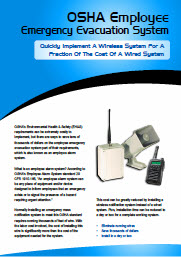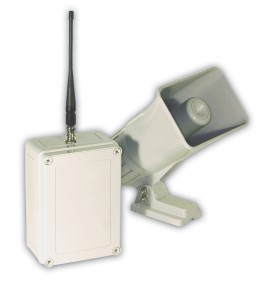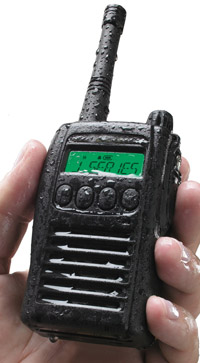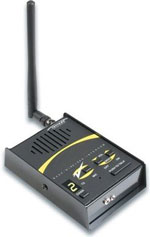A Wireless Emergency Notification System can be used to satisfy OSHA requirements for an emergency evacuation system or employee alarm system. Normally installing an emergency mass notification system in a business requires running thousands of feet of wire, which in itself can cost more than the equipment needed for the system.
Using wireless equipment, you can have a working alert system in as little as one day at a fraction of the cost of a wired system.
The heart of the system is a wireless PA system device that you place around various locations of your business. This is what lets you broadcast your message without having to run wires all around your business.
As far as activating your emergency notification system, there are a couple of different announcement options available. One is a voice announcement made by a person with a handheld radio or base station intercom. The second option is to use a device that broadcasts a previously recorded message. Both options are described below.
Wireless PA System
When installing a Wireless PA system, the single biggest expense is usually the wiring. It’s not the cost of the wire, but rather the installation cost. As in the diagram below, there is often concrete or asphalt between locations where the public address part of the system is to be installed.
Trenching through that is both expensive and messy. The expense doesn’t stop once you get inside the building and you have to start running wires through walls too.
Going with a wireless PA system instead can save you money. The PA system consists of receiver unit with antenna that receives transmissions, amplifies them, and then sends them to an attached PA horn speaker. Up to two speakers can be attached to a single receiver and pointed in different directions for greater coverage. As shown in the diagram, each receiver location can be set to different volume levels depending on the environment.
One benefit of a wireless PA system over a wired system is that you can use handheld two-way radios to make announcements. So no matter where your emergency personnel are, they can make announcements. Even if they are up to two miles away! The transmitter can be in the form of a portable 2-way radio, mobile vehicle radio, or base station intercom. There are devices that send prerecorded messages as well (see below).
One more benefit is that VHF versions of these units can also be programmed to receive transmissions from NOAA Weather Radio so employees will know instantly when bad weather is approaching.
Someone who wants to make a page to the wireless PA system just has to set the transmitter to the same channel as the wireless PA and then press the push-to-talk button on the transmitter.
The system has a range of up to a couple of miles and the range can even be extended by adding an external antenna to the Wireless PA, the transmitter, or both. These units are available in both UHF and VHF frequencies and can be programmed to work with your existing radios, or you can buy new radios.
The wireless PA does need a 110 volt power source; however there is a rechargeable battery pack that will power the unit for up to 10 hours. There is also a solar power package to operate the unit on solar power.
MURS Voice Notification Wireless Monitor
If you want to just press a button to send a recorded message over your wireless employee notification system, the MURS Voice Notification Wireless Monitor enables that.
The MURS Voice Notification Wireless Monitor (VNWM) is a wireless radio transmitter that reports changes in the status of switches by transmitting user-recorded voice messages to handheld two-way radios or base station intercoms. It transmits a recorded voice message when the switch change occurs, and at intervals you select.
Because you provide and connect the switches, your MVWM can report on the status of intrusion, tampering, equipment malfunction, liquid levels, machinery, pressure, temperature, power, smoke, or leakage.
For the Wireless Emergency Notification System application, you could put one of these devices in your command center and it enables yo u to connect two push button switches to it. One switch could transmit a voice message that says something like “Emergency, evacuate the building.” The other button could send a message like “Warning, take shelter now.” You will record the messages yourself and they can be up to 8 seconds long each. The messages can be programmed to repeat several times.
u to connect two push button switches to it. One switch could transmit a voice message that says something like “Emergency, evacuate the building.” The other button could send a message like “Warning, take shelter now.” You will record the messages yourself and they can be up to 8 seconds long each. The messages can be programmed to repeat several times.
Not only will this message be transmitted to the Wireless PA systems, but also to radio equipped personnel who will hear voice messages instantly.
VNWM is housed in a weather-resistant enclosure so it an be installed in a wide variety of indoor or outdoor locations. Because its six internal AA Alkaline batteries will power the unit for about a year, VNWM does not require AC line power. A single set of 6 AA Alkaline batteries powers the VNWM for nearly one year or approximately 12000 transmissions.
Frequencies Used
This Wireless Emergency Notification System can be obtained in UHF or VHF business band licensed frequencies. There is also equipment that uses the unlicensed MURS frequencies. MURS stands for Multi-Use Radio Service and is a two-way radio service consisting of five frequencies in the VHF (Very High Frequency) spectrum. Unlike most frequencies in the VHF range, MURS does not require an FCC license to operate.
 Even though there are only 5 channels, each channel can choose between one of 38 “quiet codes” or sub-channels to keep you from hearing conversations of other users on that channel. You will only hear conversations from radios set to the same channel and quiet code as your radio. In most areas the MURS frequencies are very lightly used so you won’t find a lot of competition for the airwaves.
Even though there are only 5 channels, each channel can choose between one of 38 “quiet codes” or sub-channels to keep you from hearing conversations of other users on that channel. You will only hear conversations from radios set to the same channel and quiet code as your radio. In most areas the MURS frequencies are very lightly used so you won’t find a lot of competition for the airwaves.
The biggest benefit of MURS is the range it offers. Some manufacturers claim a range of four miles. Of course this range is a line of sight with no obstructions between intercoms. Range can even be increased with these intercoms by adding an external high-gain antenna on top of your business, or even car if you use a unit there.
What’s nice about MURS is that you can get handheld two-way radios, commercial-duty base station and outdoor intercoms/callboxes, and even motion detectors that transmit a verbal alert message to other MURS devices. For business, industrial, or commercial applications a MURS system excels since it can overcome a lot of interference and obstacles these applications present.
This Wireless Emergency Notification System equipment can be found at http://www.intercomsonline.com.
